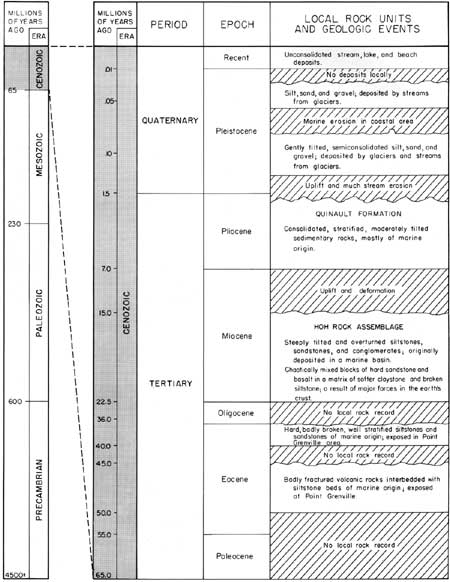
|
Washington Department of Natural Resources Geology and Earth Resources Division Bulletin No. 66 Geology of the Washington Coast between Point Grenville and the Hoh River Weldon W. Rau |
PART I
Rock Formations and Their Geologic History
GENERAL STATEMENT
Rock formations along the Washington coast provide records of at least a latter part of the earth's history. Although these records are far from continuous, and in no one place are they all in a systematic sequence, the following discussion presents a "piecing together" of those available records in a systematic order from that of the oldest to the youngest rocks known along the coast between Point Grenville and the Hoh River. Generally, fewer details can be learned about the origin of older rocks than of those most recently deposited. Alteration or metamorphism from heat and pressure, as well as periods of erosion, have either obscured or completely erased many of the details of deposition or formation of the older rocks. However, those deposited or formed most recently are relatively unaltered and appear today much as they did when they were first deposited.
VOLCANIC ROCKS OF MIDDLE EOCENE AGE
The oldest rocks known along the coast between Point Grenville and the Hoh River are largely volcanic in origin with a few interbeds of marine siltstone. These rocks form most of Point Grenville and the nearby offshore stacks (fig. 1). Microfossils contained in the interbeds of marine siltstone indicate that these rocks were formed some 45 to 50 million years ago during middle Eocene time (fig. 2). The volcanic rocks are submarine lava flows that were ejected from within the earth onto the sea floor and there, in places, were incorporated with existing sediments or mud. Rapid cooling of the magma by sea water formed large amounts of noncrystalline glass. However, over millions of years much of this material has lost its glassiness. In other places, very fine-grained, dark colored basalt was formed. Furthermore, nearly all volcanic materials were highly shattered into small angular fragments, just as hot glass would be shattered if suddenly cooled in water. Now, however, these rocks are somewhat welded together and are referred to as "volcanic breccia." Many of the original cracks or fractures are now filled with veins of secondary light-colored minerals, much of which is calcite, or in places a zeolite mineral.
The muds, or sediments, that were incorporated in the volcanic rocks are today contorted beds or layers of siltstone. Other sedimentary beds may have been deposited between periods of volcanism. Most of these beds are calcareous and in some places they contain hard nodules or concretions that form irregular, resistant layers (fig. 31).

|
| GEOLOGIC TIME CHART (Fig. 2) (click on image for an enlargement in a new window) |
SEDIMENTARY ROCKS OF LATE EOCENE AGE
Highly broken, rhythmically bedded siltstones and sandstones outcrop immediately to the north of the main volcanic body of Point Grenville, on both the north and east shores of the point (fig. 3). They dip variably, but generally to the north and northeast. Microfossils indicate that these strata were deposited some 35 to 40 million years ago during late Eocene time. These rocks are therefore distinctly younger than the nearby middle Eocene siltstone interbeds of the volcanic rocks. Local relations between these two rock units are not clearly shown because of the limited exposures and because of structural complications. However, differences in the fossils indicate that a considerable amount of geologic record is missing between the two rock units. Faulting could have brought these rocks of different ages in juxtaposition or an unconformity may be represented, in which case a period of either nondeposition or erosion took place.

|
| DIPPING BEDS OF WELL-STRATIFIED SANDSTONE AND SILTSTONE exposed along the beach immediately east of Point Grenville. Fossils indicate these rocks are 35 to 40 million years old (late Eocene). (Fig. 3) |
Rocks of late Eocene age appear to be restricted to the relatively small area near Point Grenville. Although other rocks along the coast between this area and the Hoh River are similar in appearance, none have produced fossils of late Eocene age; most are younger.
Late Eocene rocks of the Point Grenville area represent cyclic deposition in which fine-grained sediments, namely silts, were alternately deposited with coarse-grained sediments of sand. These sediments are now bedded siltstone and sandstone; and the microfossils indicate that deposition was well offshore in substantial depths of the ocean, perhaps at 1,000 feet or more, where water temperatures were relatively cold. Although these strata were deposited horizontally, or nearly so, on the sea floor as unconsolidated sediments sometime during late Eocene time, they have since been lithified, folded or tilted, and fractured by forces within the earth's crust.
| <<< Previous | <<< Contents >>> | Next >>> |
state/wa/1973-66/sec1-1.htm
Last Updated: 28-Mar-2006